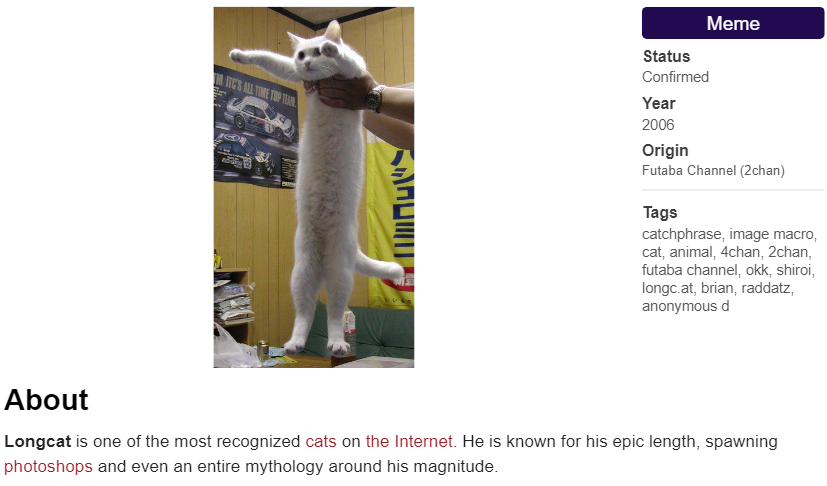Longcat is Long
Unfortunately (or fortunately?) I don’t mean this longcat:

I mean long catalog revisions 😉 (humor me, it’s late in the semester).
For this, our last entry, I’m going to talk about the longer-form revisions I undertook and then proposed.
To remind you where we are:
Three entries ago:
Blog 9 – Minor Revisions — Proposals for revisions which would not affect more than one than one entry.
Two entries ago:
Blog 10 – Hierarchal Revisions — Proposals for NTs or BTs that that do not currently exist for terms that do currently exist.
One entry ago:
Blog 11 —Original Terminology— Terms that do not currently exist in the controlled vocabulary that are being proposed for inclusion.
YOU ARE HERE:
Blog 12 – Larger Revisions Proposals for revisions which would affect more than one than one term within the vocabulary. In my final reports, these are accompanied by an Appendix which lists all of the affected terms.
Majority Report:
These are proposals for larger revisions, e.g. revisions that affect more than one than one term within the vocabulary. This section is divided up by group with reasoning. Each proposed revision is accompanied by an Appendix which lists all of the affected terms.
Total number of revisions proposed: varies, see below.
In my report, I identify 5 main areas of work, but i’ll just mention three here:
- Trans* Terms
- Sex Work Terms
- Hetero/Homosexuality Terms
Trans* Terms
~90 affected terms (multiple changes within one term counted multiply).
This section likely saw the most significant revisions. The confusion in the SNT thesaurus and language in general comes from an older decision to map Transsexual over “UF Gender dysphoria syndrome.” In the appendix I have attempted to correct this across the board by updating it to “Trans*”. If the preferred asterisk cannot be used due to technical issues (it is a Boolean) then I’ve recommend just ‘Trans’
I propose that we begin with updating ‘Gender role identification problems’ to ‘Gender dysphoria,’ removing its connection to Homosexuality as irrelevant, and then update the definition from
‘Discussions or research on the hows, whys, etc. some people assume roles inappropriate to their gender ’
to
‘Discussions or research on the hows, whys, etc. some people assume roles considered different to the gender assigned to them at birth.’
The exceptions made were for medical literature (under Transsexual surgery and sex behavior; Transsexual surgery and adjustment; and Transsexual surgery) and for Transsexual Biographies, as it is an older identity category.
See:
Brabaw, Kasandra. 54 Gender Identity Terms Every Ally Should Know. https://www.refinery29.com/en-us/gender-identity-terms. Accessed 20 Apr. 2020.
“GLAAD Media Reference Guide - Transgender.” GLAAD, 9 Sept. 2011, https://www.glaad.org/reference/transgender.
Glossary of Terms Related to Transgender Communities | Vaden Health Services. https://vaden.stanford.edu/health-resources/lgbtqia-health/transgender-health/glossary-terms-related-transgender-communities. Accessed 20 Apr. 2020.
What Are Appropriate Labels & Terms For Transgender People? https://www.plannedparenthood.org/learn/gender-identity/transgender/transgender-identity-terms-and-labels. Accessed 20 Apr. 2020.
Sex Work Terms
~60 affected terms (multiple changes within one term counted multiply).
While some consider prostitute to be a harmful word, there is by no means consensus over it. Rather, the emphasis is on recognizing the variety of forms that sex work takes: pornography, prostitution, gigolo, call girls, etc. Usually (and usefully) Prostitution is actually subset of a Sex Work.
Surprisingly, this concept is not currently in the vocabulary. It would be a useful term, as it would bring together terms such as Gigolo, Geisha, Paramour, Prostitute, etc. together. Finally, rather than alter everything (e.g. Prostitute psychoanalysis -> Sex worker analysis) I have elected to add UF’s.
Hetero/Homosexuality Terms
~60 affected terms (multiple changes within one term counted multiply).
This revision section is the smallest of them all. It is only a section because the original authors did not conceive of homosexuals as having the ability to marriage (“Two homosexuals living together, may call themselves married”). In 1976, this was more than a fair assumption—as someone born before the gay marriage decision, I’m sometimes surprised that that’s the world we live in!
As a result, marriage was defined as between a man and a woman (“General discussions of the social custom by which a man and a woman” choose to marry). Revising necessitated adding heterosexual marriage and reading throughout to try to shift the (unspoken) concept of ‘marriage’ as only heterosexual.
And that’s all folx/ks (oh no maybe I should have added that too! 😭)